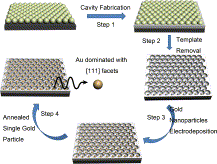Electrocatalytic oxidation of alcohols on single gold particles in highly ordered SiO2 cavities
Na Lia, b, Qun Zhoua*(周群), Shu Tiana, Hong Zhaoa, b, Xiaowei Lic, Jason Adkinsc, Zhuomin Gua, Lili Zhaoa, Junwei Zhenga, c*(郑军伟)
a College of Chemistry, Chemical Engineering and Materials Science, Soochow University, Suzhou 215123, PR China
b Department of Chemical Engineering, Huaihai Institute of Technology, Lianyungang 222005, PR China
c Institute of Chemical Power Sources, Soochow University, Suzhou 215006, PR China
Electrochimica Acta 2013, 109, 546–553
In the present work, we report a new and simple approach for preparing a highly ordered Au (1 1 1) nanoparticle (NP) array in SiO2 cavities on indium-doped tin oxide (ITO) electrodes. We fabricated a SiO2 cavity array on the surface of an ITO electrode using highly ordered self-assembly of polystyrene spheres as a template. Gold NPs were electrodeposited at the bottom of the SiO2 cavities, and single gold NPs dominated with (1 1 1) facets were generated in each cavity by annealing the electrode at a high temperature. Such (1 1 1) facets were the predominate trait of the single gold particle which exhibited considerable electrocatalytic activity toward oxidation of methanol, ethanol, and glycerol. This has been attributed to the formation of incipient hydrous oxides at unusually low potential on the specific (1 1 1) facet of the gold particles. Moreover, each cavity of the SiO2 possibly behaves as an independent electrochemical cell in which the methanol molecules are trapped; this produces an environment advantageous to catalyzing electrooxidation. The oxidation of methanol on the electrodes is a mixed control mechanism (both by diffusion and electrode kinetics). This strategy both provided an approach to study electrochemical reactions on a single particle in a microenvironment and may supply a way to construct alcohols sensors.

链接: //www.sciencedirect.com/science/article/pii/S0013468613014059